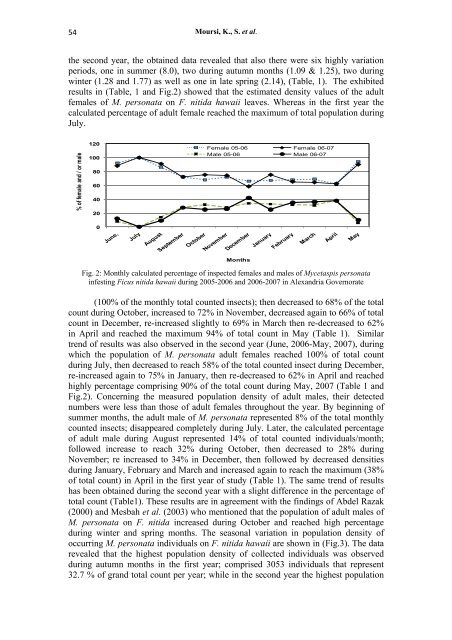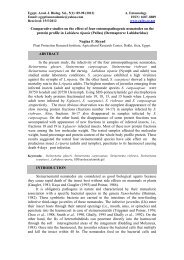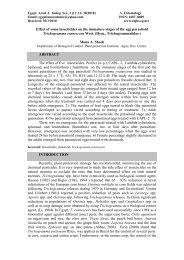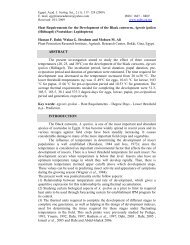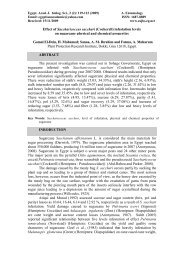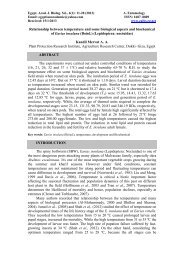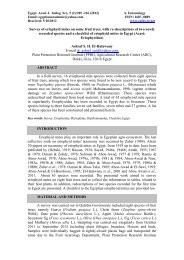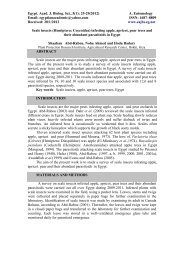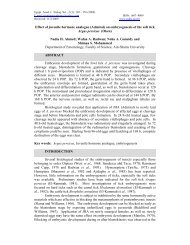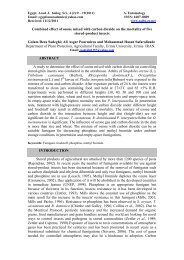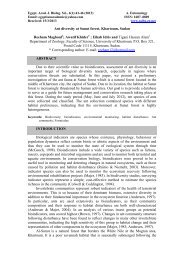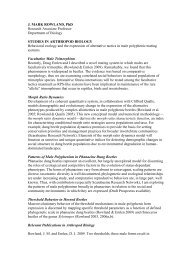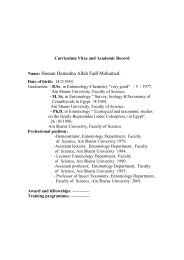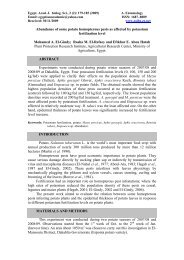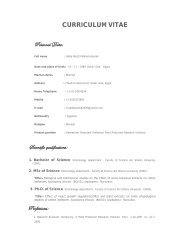(Hemiptera: Diaspididae) infesting Ficus nitida hawaii in
(Hemiptera: Diaspididae) infesting Ficus nitida hawaii in
(Hemiptera: Diaspididae) infesting Ficus nitida hawaii in
Create successful ePaper yourself
Turn your PDF publications into a flip-book with our unique Google optimized e-Paper software.
54<br />
Moursi, K., S. et al.<br />
the second year, the obta<strong>in</strong>ed data revealed that also there were six highly variation<br />
periods, one <strong>in</strong> summer (8.0), two dur<strong>in</strong>g autumn months (1.09 & 1.25), two dur<strong>in</strong>g<br />
w<strong>in</strong>ter (1.28 and 1.77) as well as one <strong>in</strong> late spr<strong>in</strong>g (2.14), (Table, 1). The exhibited<br />
results <strong>in</strong> (Table, 1 and Fig.2) showed that the estimated density values of the adult<br />
females of M. personata on F. <strong>nitida</strong> <strong>hawaii</strong> leaves. Whereas <strong>in</strong> the first year the<br />
calculated percentage of adult female reached the maximum of total population dur<strong>in</strong>g<br />
July.<br />
% of female and / or male<br />
120<br />
100<br />
80<br />
60<br />
40<br />
20<br />
0<br />
Female 05-06 Female 06-07<br />
Male 05-06 Male 06-07<br />
Months<br />
Fig. 2: Monthly calculated percentage of <strong>in</strong>spected females and males of Mycetaspis personata<br />
<strong><strong>in</strong>fest<strong>in</strong>g</strong> <strong>Ficus</strong> <strong>nitida</strong> <strong>hawaii</strong> dur<strong>in</strong>g 2005-2006 and 2006-2007 <strong>in</strong> Alexandria Governorate<br />
(100% of the monthly total counted <strong>in</strong>sects); then decreased to 68% of the total<br />
count dur<strong>in</strong>g October, <strong>in</strong>creased to 72% <strong>in</strong> November, decreased aga<strong>in</strong> to 66% of total<br />
count <strong>in</strong> December, re-<strong>in</strong>creased slightly to 69% <strong>in</strong> March then re-decreased to 62%<br />
<strong>in</strong> April and reached the maximum 94% of total count <strong>in</strong> May (Table 1). Similar<br />
trend of results was also observed <strong>in</strong> the second year (June, 2006-May, 2007), dur<strong>in</strong>g<br />
which the population of M. personata adult females reached 100% of total count<br />
dur<strong>in</strong>g July, then decreased to reach 58% of the total counted <strong>in</strong>sect dur<strong>in</strong>g December,<br />
re-<strong>in</strong>creased aga<strong>in</strong> to 75% <strong>in</strong> January, then re-decreased to 62% <strong>in</strong> April and reached<br />
highly percentage compris<strong>in</strong>g 90% of the total count dur<strong>in</strong>g May, 2007 (Table 1 and<br />
Fig.2). Concern<strong>in</strong>g the measured population density of adult males, their detected<br />
numbers were less than those of adult females throughout the year. By beg<strong>in</strong>n<strong>in</strong>g of<br />
summer months, the adult male of M. personata represented 8% of the total monthly<br />
counted <strong>in</strong>sects; disappeared completely dur<strong>in</strong>g July. Later, the calculated percentage<br />
of adult male dur<strong>in</strong>g August represented 14% of total counted <strong>in</strong>dividuals/month;<br />
followed <strong>in</strong>crease to reach 32% dur<strong>in</strong>g October, then decreased to 28% dur<strong>in</strong>g<br />
November; re <strong>in</strong>creased to 34% <strong>in</strong> December, then followed by decreased densities<br />
dur<strong>in</strong>g January, February and March and <strong>in</strong>creased aga<strong>in</strong> to reach the maximum (38%<br />
of total count) <strong>in</strong> April <strong>in</strong> the first year of study (Table 1). The same trend of results<br />
has been obta<strong>in</strong>ed dur<strong>in</strong>g the second year with a slight difference <strong>in</strong> the percentage of<br />
total count (Table1). These results are <strong>in</strong> agreement with the f<strong>in</strong>d<strong>in</strong>gs of Abdel Razak<br />
(2000) and Mesbah et al. (2003) who mentioned that the population of adult males of<br />
M. personata on F. <strong>nitida</strong> <strong>in</strong>creased dur<strong>in</strong>g October and reached high percentage<br />
dur<strong>in</strong>g w<strong>in</strong>ter and spr<strong>in</strong>g months. The seasonal variation <strong>in</strong> population density of<br />
occurr<strong>in</strong>g M. personata <strong>in</strong>dividuals on F. <strong>nitida</strong> <strong>hawaii</strong> are shown <strong>in</strong> (Fig.3). The data<br />
revealed that the highest population density of collected <strong>in</strong>dividuals was observed<br />
dur<strong>in</strong>g autumn months <strong>in</strong> the first year; comprised 3053 <strong>in</strong>dividuals that represent<br />
32.7 % of grand total count per year; while <strong>in</strong> the second year the highest population


